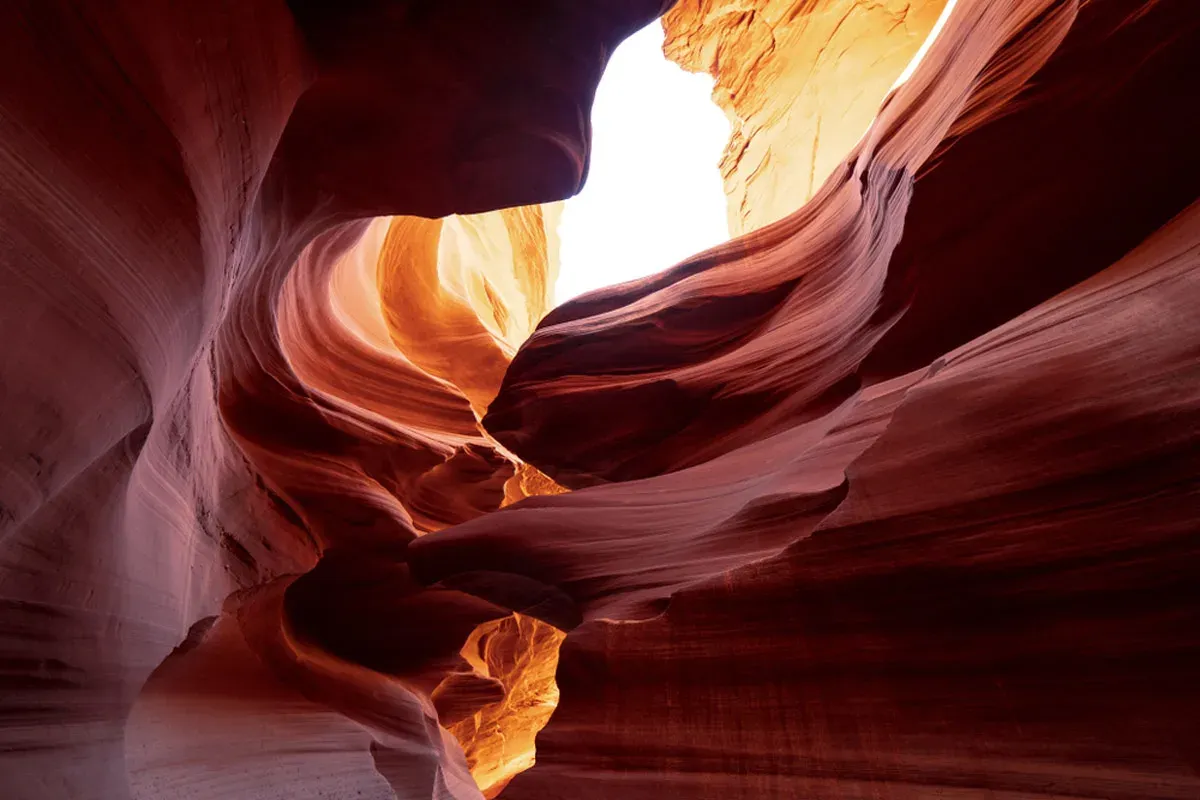Zion National Park is a place of unparalleled natural beauty, a landscape carved by wind and water into towering cliffs, verdant valleys, and, of course, incredible caves and slot canyons. As an avid adventurer and someone who's had the privilege of exploring many of these hidden gems, I can tell you that the Zion National Park caves offer some of the most unique and unforgettable experiences you'll find anywhere. From the easily accessible to the truly challenging, these geological wonders are a testament to the raw power of nature and a thrill for any explorer.
In this guide from National Park Shops, I'll take you on a journey through 14 of these remarkable Zion National Park caves and slot canyons. While some are technically outside the park boundaries, they are all within easy reach and offer a similar, breathtaking experience. Get ready to discover some must-visit spots that will leave you in awe of Utah's stunning landscapes.
Moqui Caverns/Sand Caves
My first encounter with the magic of the Zion National Park caves wasn't actually within the park itself, but just a short drive away, between Zion and Kanab. The Moqui Caverns, often referred to as the Sand Caves, are a fascinating example of human interaction with nature. These aren't natural caves in the traditional sense; they were carved out by early settlers for sand mining. But don't let that deter you – their unique formations and accessible nature make them a truly worthwhile stop.
I remember pulling off Highway 89 and seeing these intriguing openings in the sandstone cliffs. The hike up is relatively short and easy, though there's a bit of a scramble to get into the caves themselves. I'd definitely recommend wearing shoes with good grip, as the sand can be surprisingly slippery, especially on the steeper sections. Once inside, the soft, fine sand underfoot is a delight, and I saw plenty of families with kids having a blast, almost as if it were a giant sandbox. The light filtering in through the openings creates a beautiful, ethereal glow, making it a photographer's dream. It's a quick adventure, perfect for stretching your legs and capturing some unique photos, especially around sunset when the colors are truly magical. Just be mindful of the sheer drop-offs if you're traveling with little ones.
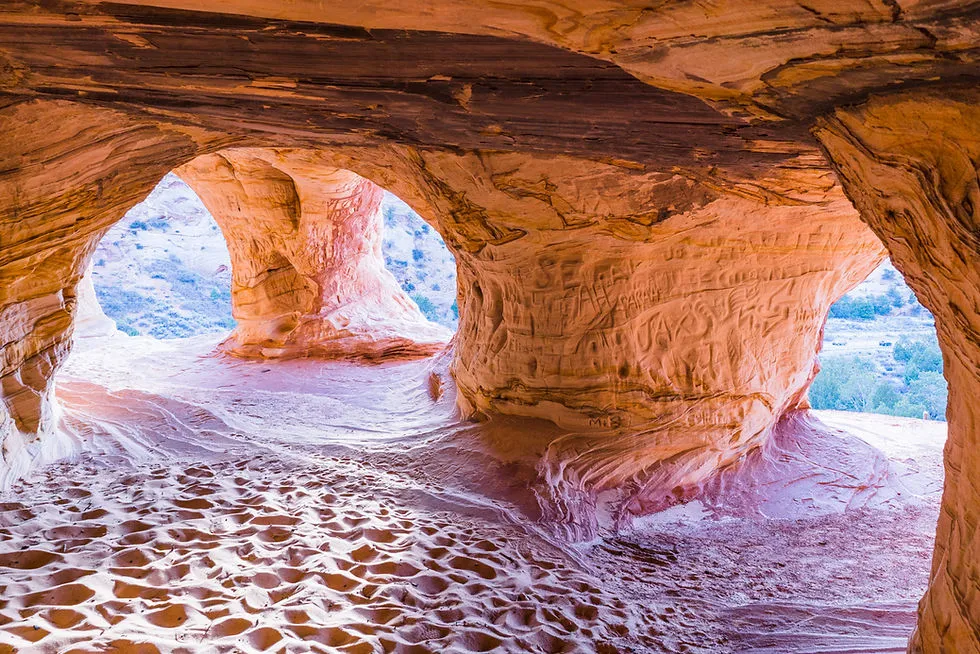
Mammoth Cave
While not directly inside Zion National Park, Mammoth Cave, located in Dixie National Forest near Bryce Canyon, is another fantastic example of the diverse geological wonders surrounding the area. This isn't your typical limestone cave; it's actually Utah's longest lava tube, a fascinating underground passage formed by flowing lava. I remember being struck by how different it felt from other caves I'd explored – the smooth, dark walls of solidified lava were a stark contrast to the rough, sandy textures of the Moqui Caverns.
Exploring Mammoth Cave is a relatively easy and family-friendly experience. There are multiple entrances, and you can wander through various chambers. The air inside is cool and refreshing, a welcome respite on a hot Utah day. One thing I quickly realized is the importance of a good flashlight or headlamp; it gets quite dark in there! While it lacks the dramatic stalactites and stalagmites you might associate with some caves, the sheer scale of the lava tube and the unique formations created by the cooling lava are impressive in their own right. It's a great spot to spend an hour or two, offering a glimpse into a different kind of subterranean world. If you're looking for more Zion National Park caves to explore, this nearby gem is definitely worth the short drive.
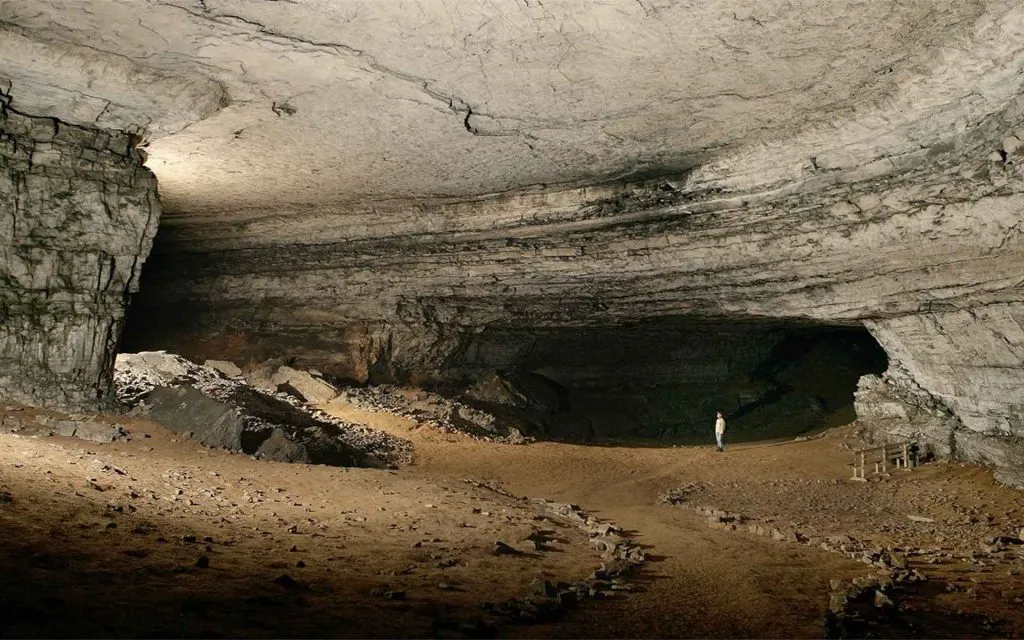
Upper Red Cave
Upper Red Cave, situated east of Zion National Park near Mount Carmel, is a slot canyon that truly lives up to its name with its vibrant red hues. This isn't a casual stroll; it's a canyoneer's dream, offering a more technical and exhilarating experience than the previous two. I recall the anticipation building as we approached the narrow entrance, knowing that what lay ahead would be a test of skill and nerve.
The canyon is characterized by its incredibly narrow passages and challenging obstacles, including steep drops and often frigid water. While the vibrant colors are breathtaking, especially when the light filters down into the depths, it's crucial to understand that this is a technical route. You'll need proper canyoneering gear – ropes, a harness, a descender, and a helmet are non-negotiable. Wetsuits are also highly recommended, as the water can be shockingly cold, even on a warm day. This is definitely not a place for beginners to venture alone. If you're new to canyoneering, I strongly advise going with an experienced guide. The rewards, however, are immense: a truly immersive experience within one of the most stunning and challenging Zion National Park caves (or rather, slot canyons) in the region. Always check for permits and current conditions before attempting this adventure.
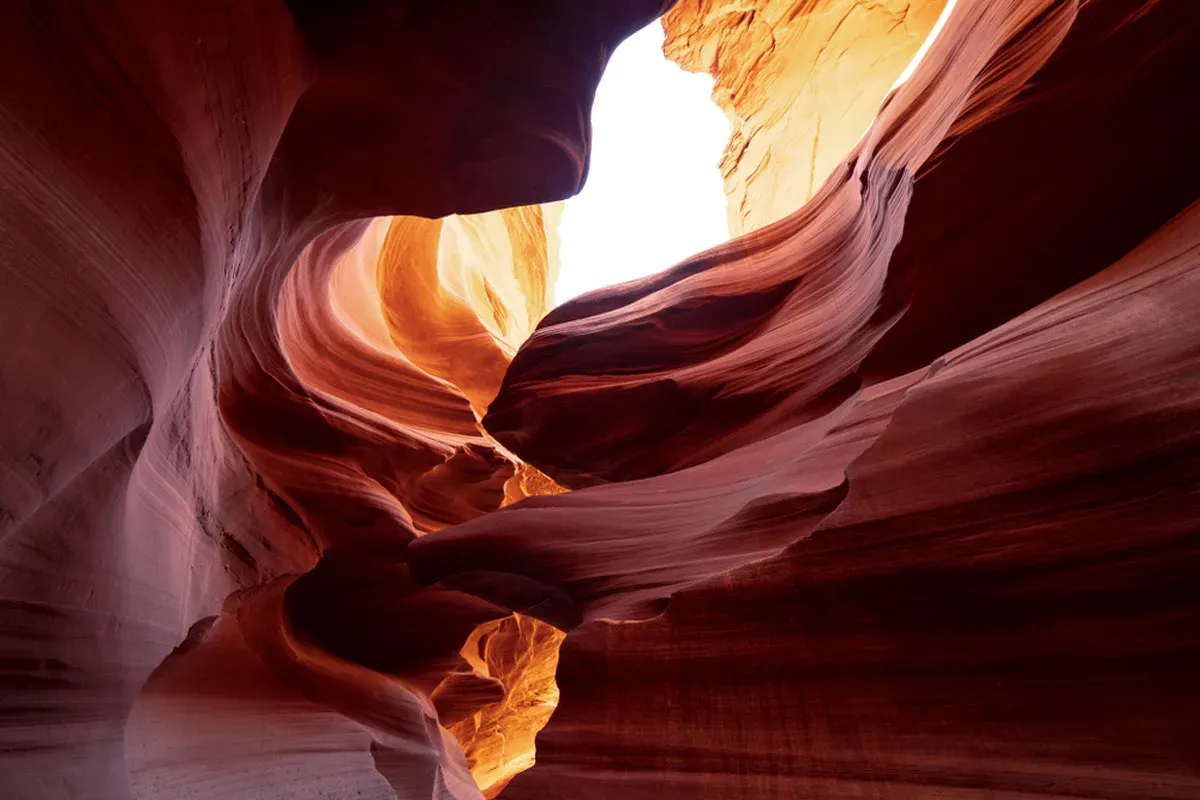
Peekaboo Slot Canyon
Peekaboo Slot Canyon, located near Kanab and within the Grand Staircase-Escalante National Monument, is another one of those incredible slot canyons that, while not technically a Zion National Park cave, offers a similar awe-inspiring experience. This canyon is famous for its stunning, sculpted sandstone walls and the way the light plays within its narrow confines, creating a truly magical atmosphere. I remember feeling like I was walking through a work of art, with every turn revealing a new pattern and shade of red and orange.
This is a non-technical slot canyon, making it more accessible than Upper Red Cave, but it still requires some effort. The drive to the trailhead often requires a high-clearance 4WD vehicle, and I’ve seen many visitors opt for guided tours to navigate the sandy roads. Once you start hiking, it’s a relatively short walk, but you’ll want to take your time to soak in the beauty. There’s a notable 12-foot climb or scramble to get into the canyon itself, which can be a bit challenging, but it’s manageable with a little determination. Inside, the narrow passages can be tight, and you’ll find yourself squeezing through some sections, adding to the adventure. It’s incredibly photogenic, so make sure your camera is ready! Just remember to secure a permit beforehand, as it’s required for this area, and be prepared for crowds, especially during peak season, as its beauty is no secret.
>> Read More: 16 Best Hikes in Zion National Park, Ranked from Easy to Hard
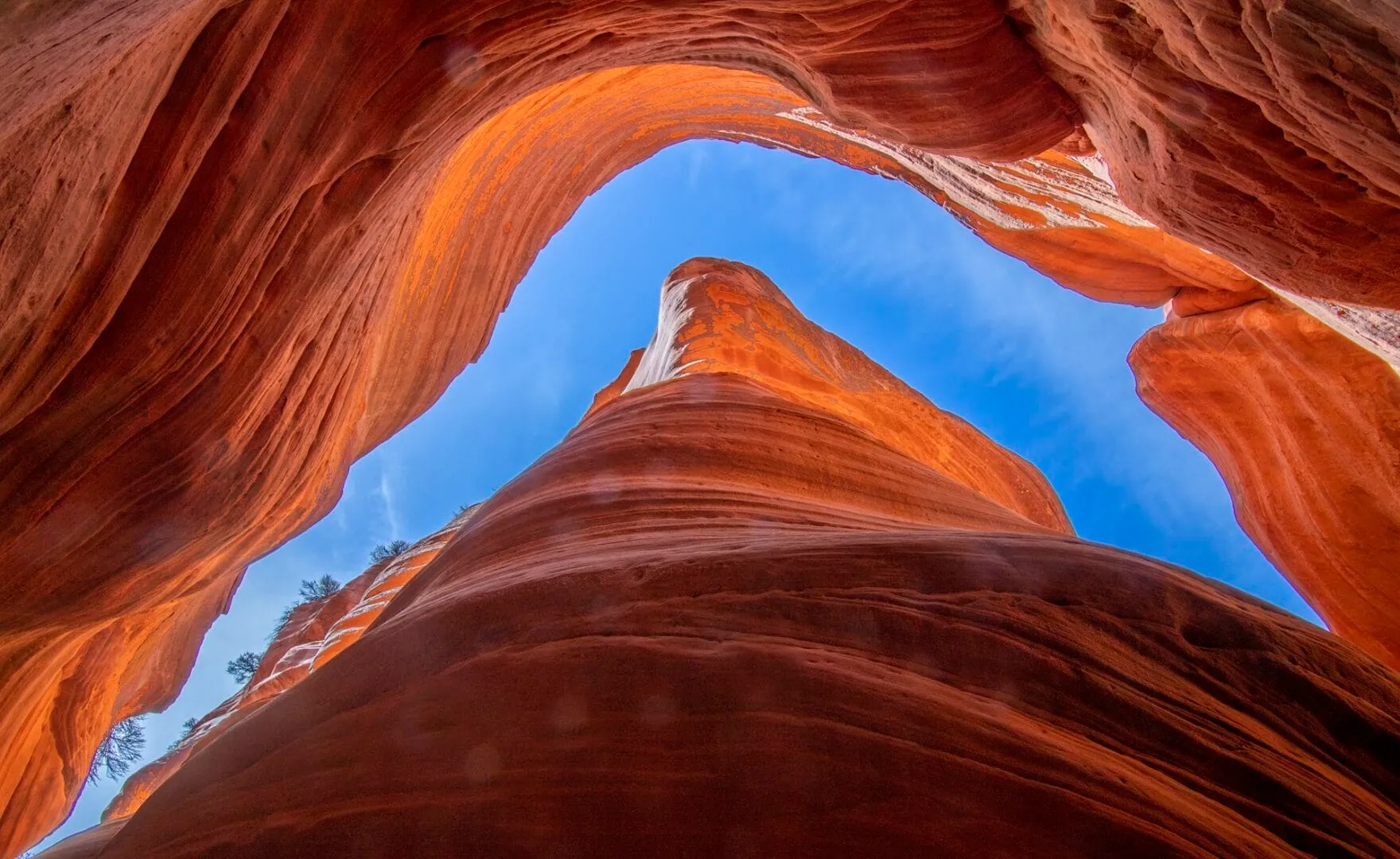
Belly of the Dragon
Just a short drive from the East Entrance of Zion National Park, you’ll find a quirky and surprisingly captivating spot known as the Belly of the Dragon. This isn't a natural cave or slot canyon in the traditional sense; it's actually a man-made drainage tunnel that runs beneath Highway 89. But trust me, it's far more interesting than it sounds! I first heard about it from a local and decided to check it out, and I'm so glad I did.
The tunnel's corrugated walls, carved by years of water flow, create a unique, almost otherworldly effect. It’s a short, easy walk through the tunnel, making it perfect for families or anyone looking for a quick, fun adventure. There might be a small drop at the entrance, but it’s easily navigated. It’s a fantastic spot for some truly unique photos, especially if you catch the light just right. It’s a great little detour if you’re passing through the area, offering a different kind of subterranean experience compared to the grand Zion National Park caves.
>> Read More: The Best Zion National Park Waterfalls: Discover A Gorgeous
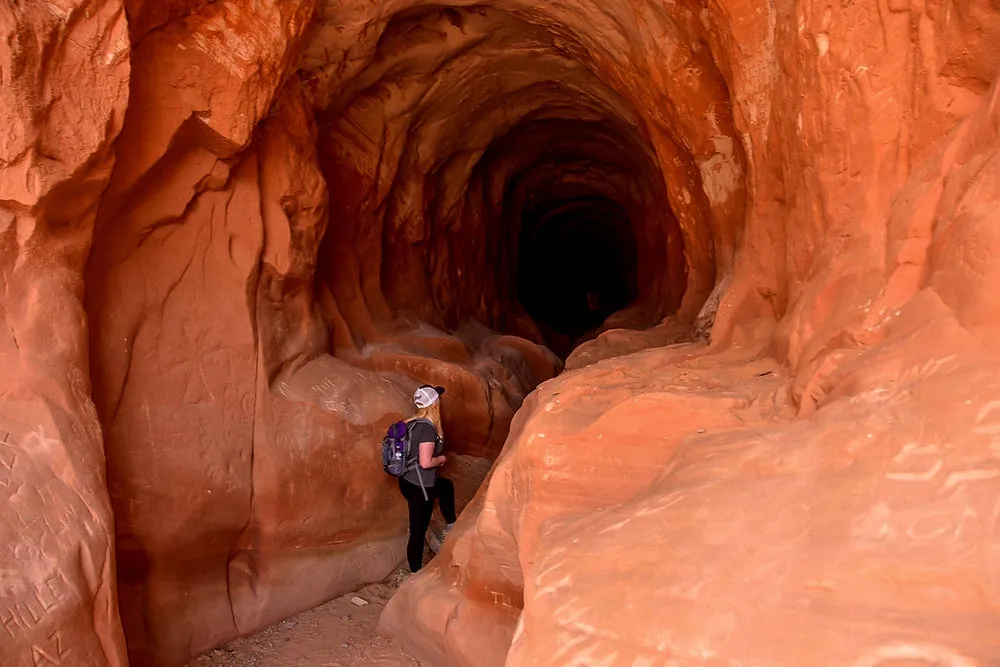
The Narrows
When people talk about iconic hikes in Zion National Park, The Narrows is almost always at the top of the list. This isn't a cave in the traditional sense, but rather a slot canyon carved by the Virgin River, where the canyon walls are so close you're literally hiking in the river itself. My experience in The Narrows was nothing short of epic. It's a truly immersive adventure that challenges you physically while surrounding you with breathtaking beauty.
There are two main ways to experience The Narrows: bottom-up or top-down. I opted for the bottom-up approach, which doesn't require a permit for the first few miles. Even just a few hours into the canyon from the Riverside Walk, you're enveloped by towering sandstone walls, some a thousand feet high, with the river sometimes narrowing to just twenty feet wide. The water can be cold, and you'll be wading, sometimes even swimming, through sections. Renting canyoneering shoes and neoprene socks from a local outfitter was a game-changer for me – the grip on the slippery riverbed is essential, and the neoprene keeps your feet surprisingly warm. Hiking poles are also an absolute must for stability against the current and uneven riverbed.
It's crucial to check the weather forecast before you go; flash floods are a serious danger in slot canyons, and The Narrows closes if there's any risk. The beauty of this place is unparalleled, with sunlight filtering down into the depths, creating dramatic light and shadow. It's a truly unforgettable experience, and while it's physically demanding, the reward of being surrounded by such raw, natural grandeur is immense. This is arguably the most famous of the Zion National Park caves (or slot canyons) and for good reason.
>> Read More: 16 Best Things to Do in Zion National Park: Unique Experiences
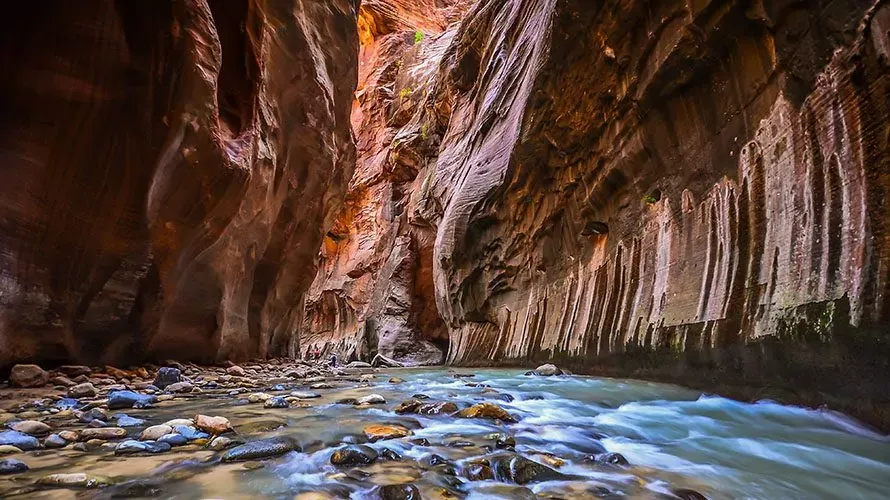
Weeping Rock
Weeping Rock is one of those classic Zion landmarks that’s both beautiful and fascinating. It’s a large, bowl-shaped alcove where water, which has been slowly seeping through the sandstone for centuries, finally emerges, creating a constant “weeping” effect. The result is a lush hanging garden of ferns and mosses, a vibrant green oasis against the red rock. I remember being mesmerized by the gentle sound of the dripping water and the cool, misty air – a welcome relief from the desert sun.
The hike to Weeping Rock is short and steep, but it’s paved, making it accessible to a wide range of visitors. It’s a great spot for families and anyone looking for a quick, rewarding hike. The view from under the alcove, looking out at the main canyon, is simply stunning. It’s a perfect example of the unique and diverse beauty you can find within the Zion National Park caves and alcoves. It is important to note that the Weeping Rock trail has been closed due to a significant rockfall. Please check the official Zion National Park website for the most current trail status before planning your visit.
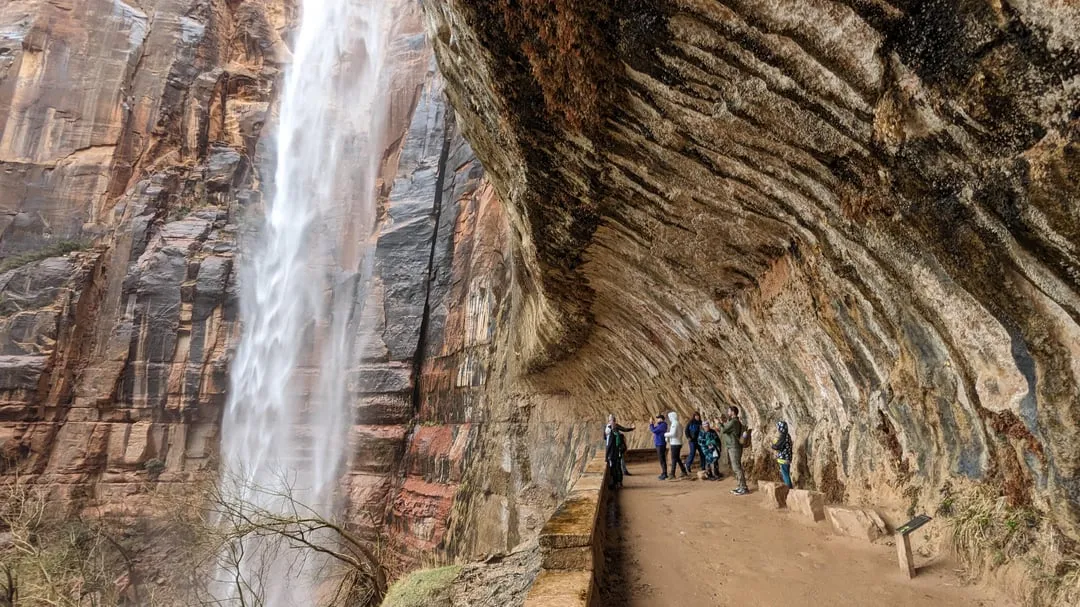
Keyhole Canyon
For those with a taste for adventure and the right skills, Keyhole Canyon offers a thrilling introduction to the world of technical canyoneering in Zion. Located near the East Entrance of the park, this short but spectacular slot canyon is a popular choice for both beginners and experienced canyoneers. My first time in Keyhole was an adrenaline-pumping experience, with a series of rappels, down-climbs, and swims through chilly water.
This is not a hike; it’s a technical canyoneering route that requires proper gear and experience. You’ll need ropes, a harness, a descender, and a helmet, and a wetsuit is highly recommended, as the water can be surprisingly cold, even in the Zion summer. The canyon is incredibly narrow in places, with beautiful, sculpted walls that create a sense of being in another world. It’s a short route, typically taking only a couple of hours to complete, but it’s packed with adventure.
If you’re new to canyoneering, I strongly recommend going with a certified guide. It’s a fantastic way to experience the more adventurous side of the Zion National Park caves and slot canyons, but safety should always be your top priority. Remember to secure a permit from the park before you go.
>> Read More: How Many Days To Spend In Zion National Park: Full Itinerary
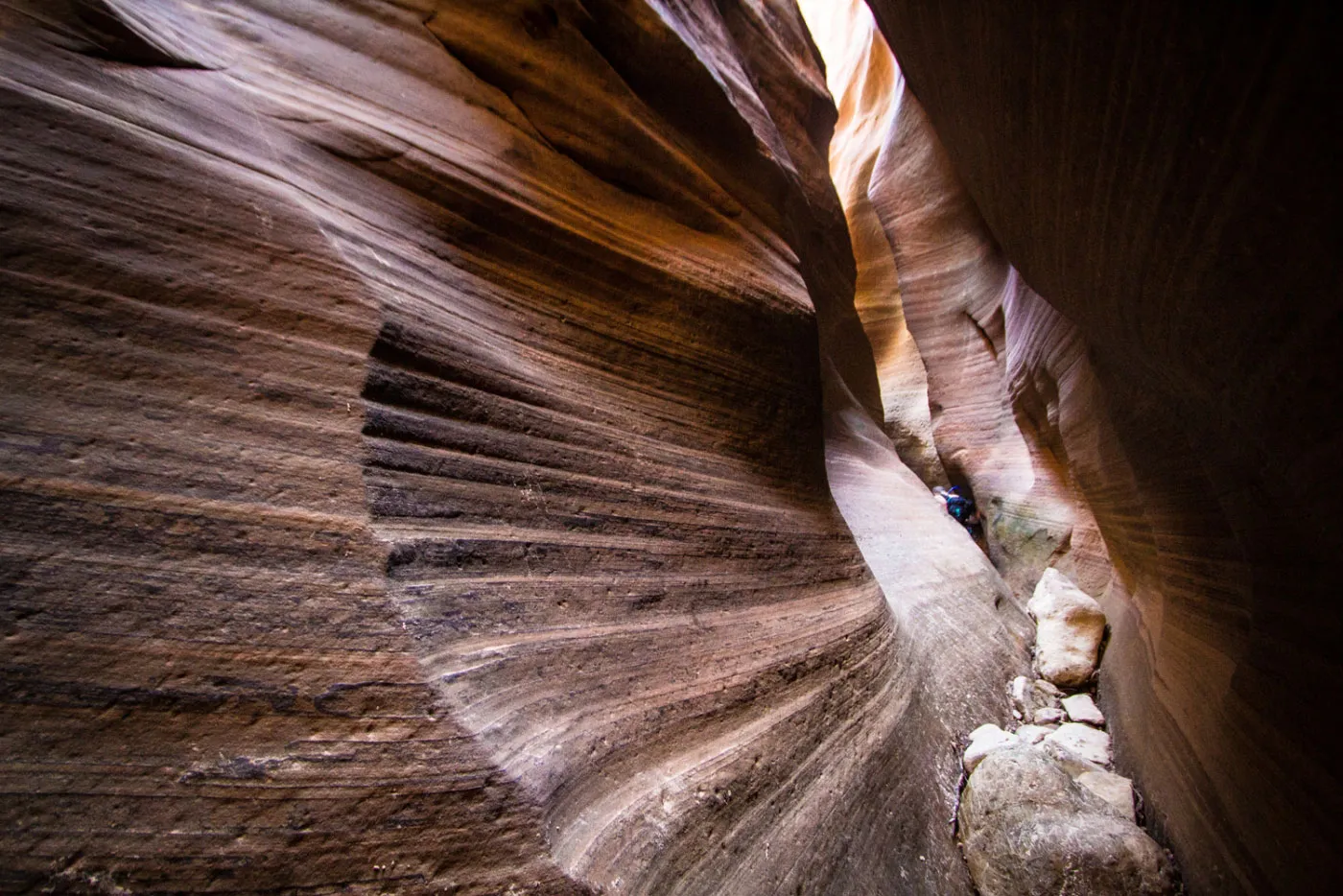
Red Hollow Canyon
If you’re looking for a slot canyon experience that’s a bit more approachable than Upper Red Cave or Keyhole Canyon, Red Hollow Canyon, near Orderville, is an excellent choice. While not officially one of the Zion National Park caves, it’s close enough to be a fantastic addition to any Zion itinerary. I found Red Hollow to be a perfect introduction to slot canyons for those who might be a little hesitant about the more technical routes.
The hike through Red Hollow is relatively short and easy, typically around 1.2 miles round trip. You’ll be walking through a sandy wash, which can be a bit of a workout, but the vibrant red walls of the canyon are incredibly rewarding. There are some sections that require a bit of scrambling, but nothing too challenging. The beauty of Red Hollow lies in its accessibility and its stunning, narrow passages that glow with rich red and orange hues when the sun hits them just right.
It’s a great spot for families and offers a taste of the slot canyon experience without the need for specialized gear or advanced skills. Just remember to bring plenty of water, as there’s little shade, and always be aware of flash flood warnings, as with any slot canyon.
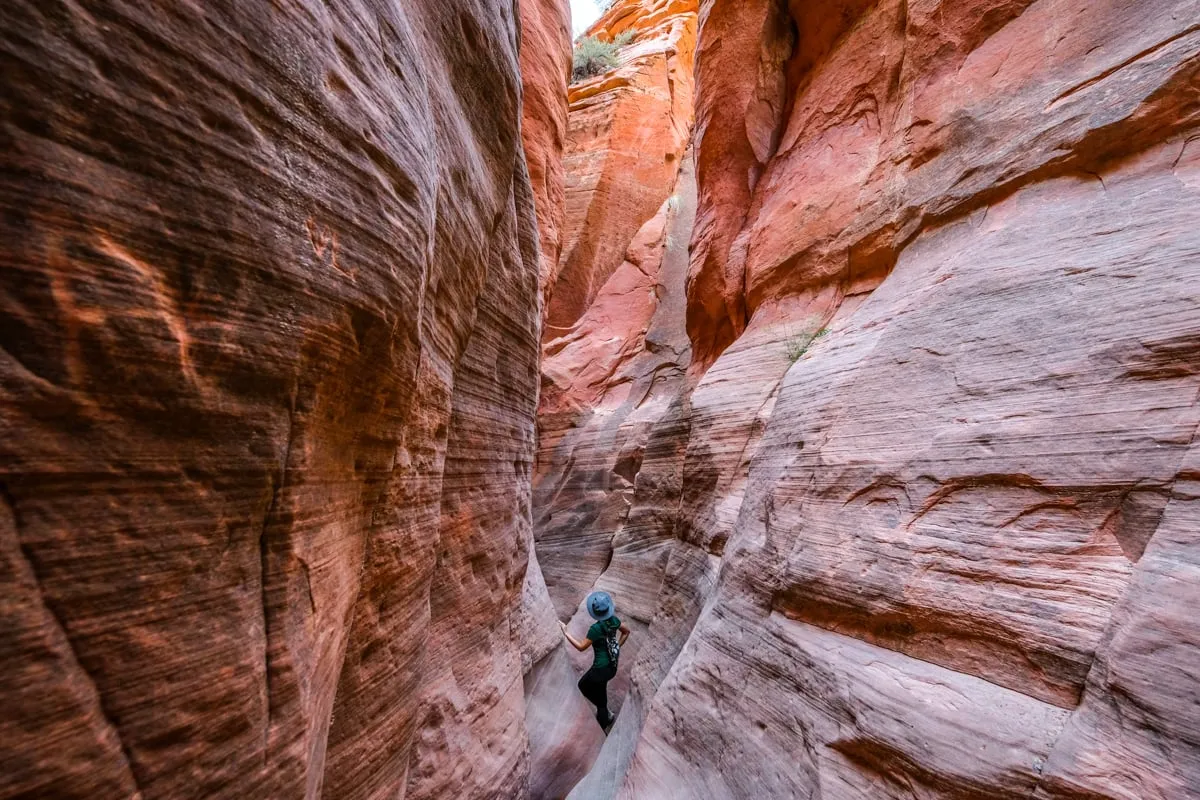
Buckskin Gulch via Wirepass Trailhead
Buckskin Gulch, accessed via the Wirepass Trailhead, is not just a slot canyon; it’s an epic journey through one of the longest and deepest slot canyons in the world. While it’s located outside of Zion National Park in the Paria Canyon-Vermilion Cliffs Wilderness Area, it’s an absolute must-do for any serious adventurer visiting the region. My hike through Buckskin Gulch was an unforgettable experience, a true test of endurance and a feast for the eyes.
The canyon walls here are immense, towering hundreds of feet above you, and the passages can be incredibly narrow, sometimes just wide enough for a single person to squeeze through. You’ll encounter sections with deep, often muddy, pools that can be chest-deep, requiring you to wade or even swim. The light filtering down into these depths creates dramatic contrasts and highlights the incredible striations and colors of the sandstone. It’s a challenging hike, and you need to be prepared for varied terrain, including scrambling over obstacles and navigating through water. The sheer scale and continuous nature of the narrows are what make Buckskin Gulch so unique.
Tips:
- Permit: A permit is absolutely essential for Buckskin Gulch, whether you’re doing a day hike or an overnight trip. Obtain it in advance, as they are limited and cell service is non-existent at the trailhead.
- Flash Flood Danger: This is paramount. Buckskin Gulch is extremely susceptible to flash floods. Check the Zion weather forecast for a wide area (not just the immediate vicinity) and do not enter if there’s any chance of rain.
- Gear: Be prepared to get wet and muddy. Waterproof hiking boots or canyoneering shoes, neoprene socks, and a dry bag for all your valuables are crucial. Trekking poles are highly recommended for stability.
- Accessibility: The road to the Wirepass Trailhead can be rough, especially after rain. A high-clearance 2WD or 4WD vehicle is often advisable.
- Duration: Even a day hike to the confluence of Wire Pass and Buckskin Gulch is a significant undertaking (around 6-8 miles round trip). Bring plenty of water and snacks.
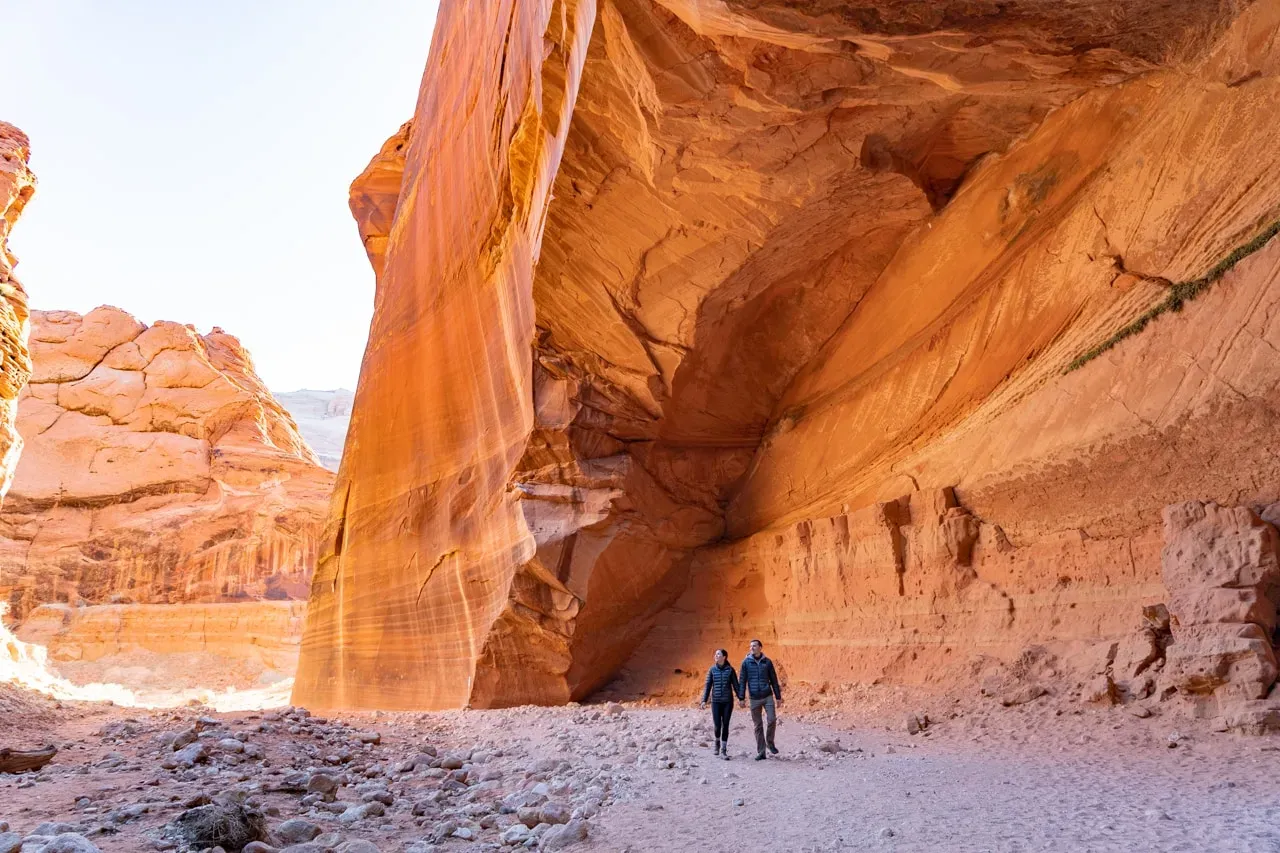
The Subway
The Subway, officially known as the Left Fork of North Creek, is arguably one of the most iconic and sought-after canyoneering experiences in Zion National Park. It’s a place of almost surreal beauty, with its unique, tube-like rock formations and emerald pools. My journey to The Subway was one of the most challenging yet rewarding adventures I’ve ever undertaken, a true test of navigation, endurance, and problem-solving.
There are two main ways to experience The Subway: the top-down technical route and the bottom-up non-technical hike. Both require a wilderness permit, which is highly competitive and obtained through a lottery system. I opted for the bottom-up hike, which is a strenuous 9-mile round trip involving significant route finding, hiking in ankle to knee-deep water, scrambling over boulders, and navigating through dense vegetation. The highlight, of course, is reaching the famous ‘Subway’ section itself, where the water has carved a perfectly rounded tunnel through the rock, creating a mesmerizing scene.
Tips:
- Permit: A permit is absolutely essential and extremely difficult to get. Plan well in advance and be persistent with the lottery.
- Gear: Sturdy waterproof hiking boots or canyoneering shoes, neoprene socks, and trekking poles are highly recommended. A dry bag is crucial for protecting electronics and other valuables.
- Physical Fitness: This is a very strenuous hike. Be prepared for a long day of challenging terrain, including slippery rocks, cold water, and significant elevation changes.
- Navigation: The trail is not always clearly marked, especially on the bottom-up route. Good navigational skills and a reliable map/GPS are vital.
- Flash Flood Danger: As with all slot canyons, check the weather forecast meticulously. Flash floods are a serious risk.
- Accessibility: This is a wilderness route and is not accessible for those with mobility limitations.
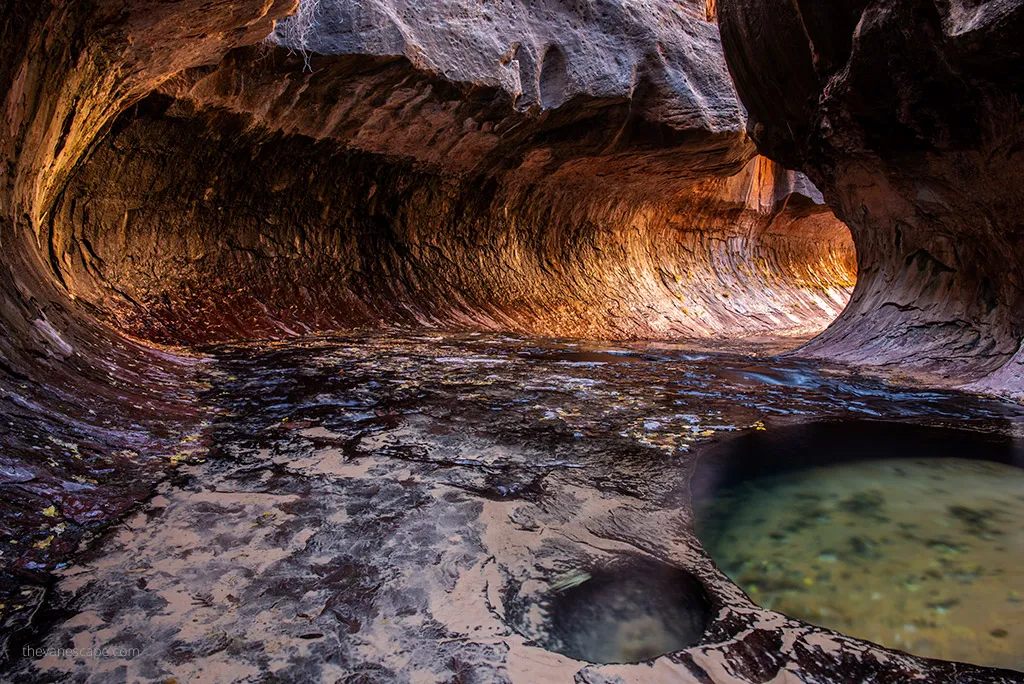
Spring Creek Canyon
Spring Creek Canyon, located near Kanarraville, just outside of Zion National Park, offers a delightful and less-trafficked slot canyon experience. It’s a fantastic alternative if you’re looking to escape the crowds of Zion while still immersing yourself in Utah’s stunning canyon landscapes. My visit to Spring Creek Canyon was a refreshing change of pace, a serene journey through winding sandstone passages.
This canyon is known for its beautiful, narrow walls and the gentle stream that flows through it, requiring numerous stream crossings. It’s generally considered a family-friendly hike, with relatively easy terrain, though you’ll encounter some fun rock scrambling sections. The water levels can vary, so be prepared for your feet to get wet – waterproof shoes or sandals are definitely a good idea. The canyon offers picturesque views, and the feeling of solitude you can find here is truly special. Spring and fall are particularly beautiful times to visit Zion, with pleasant temperatures and vibrant foliage. It’s a great way to experience the unique geology of the region without the technical demands of some of the more challenging Zion National Park caves and canyons.
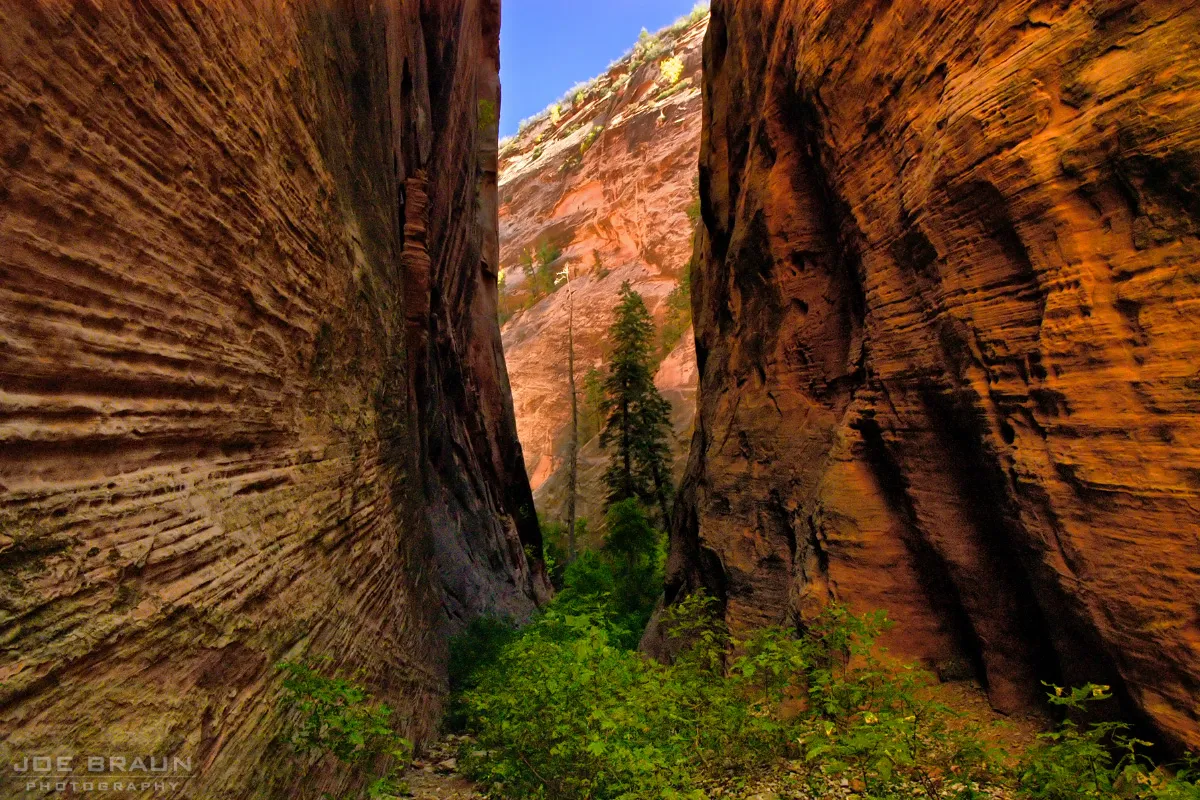
Lower Red Cave
Similar to its upper counterpart, Lower Red Cave is another technical slot canyon located near Orderville, outside the immediate boundaries of Zion National Park, but very much part of the greater Zion experience for canyoneering enthusiasts. While Upper Red Cave is known for its vibrant colors and challenging narrows, Lower Red Cave presents its own set of unique obstacles, including two significant 40-foot drops that require rappelling. My experience here reinforced the importance of proper training and equipment.
This is unequivocally a technical canyoneering route. It is not a hiking trail, and attempting it without the necessary skills, gear (ropes, harness, descender, helmet), and a solid understanding of rappelling techniques would be extremely dangerous. The canyon can also be filled with sand and water, and conditions can change rapidly, making route-finding and obstacle negotiation variable. The beauty of Lower Red Cave lies in its raw, untamed nature and the sense of accomplishment you feel after successfully navigating its challenges. If you are an experienced canyoneer, or are going with a certified guide, this can be an incredibly rewarding adventure, offering a deeper dive into the rugged beauty of the region’s slot canyons. Always obtain the necessary permits and check current conditions before embarking on this serious adventure.
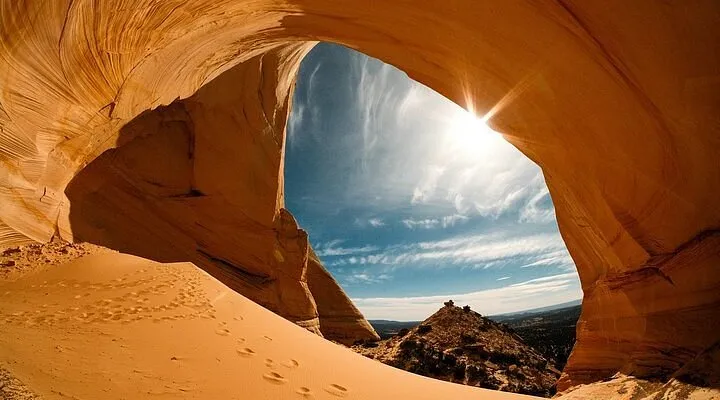
Conclusion
Exploring the Zion National Park caves and the incredible slot canyons in its surrounding areas has been one of the most enriching experiences of my life. From the easily accessible Moqui Caverns to the challenging depths of The Narrows and The Subway, each location offers a unique glimpse into the geological artistry of Mother Nature. These aren't just holes in the ground; they are living, breathing landscapes that tell stories of ancient floods, shifting sands, and the relentless power of water.
I hope this guide inspires you to venture beyond the main trails and discover the hidden wonders that lie within and around Zion National Park. The memories you make exploring these magnificent Zion National Park caves will undoubtedly last a lifetime. Happy exploring!
>> Read More:

